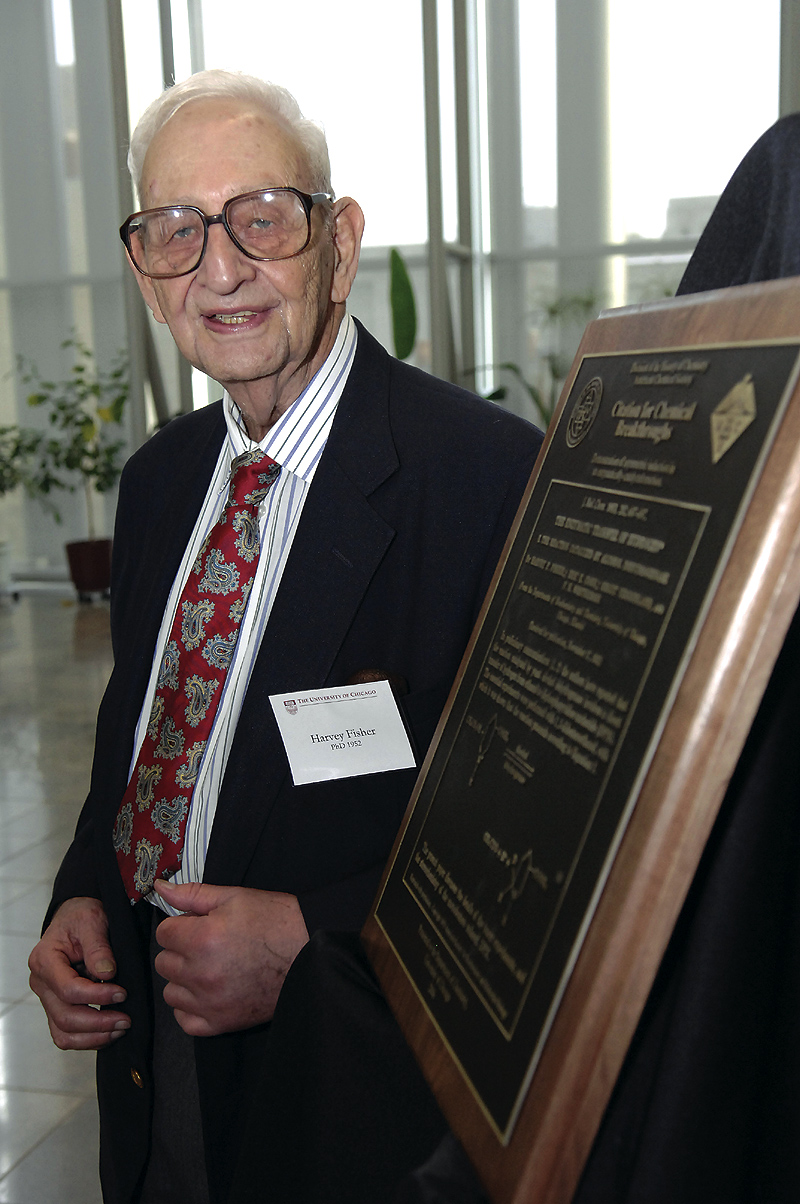American Chemical Society honors authors of scientific papers and breakthrough findings
By Steve KoppesNews Office
 Harvey Fisher Photo by Lloyd DeGrane | |
After completing tours of duty as a combat engineer in Germany and the Philippines during World War II, Harvey Fisher resumed his studies at the University in the autumn of 1947. Working under the mentorship of Professors Frank Westheimer and Birgit Vennesland six years later, Fisher became the first author of a landmark paper published in the Journal of Biological Chemistry.
“It was done with only one explosion and two hospitalizations,” quipped Fisher, now a professor of biochemistry and molecular biology at the Kansas University Medical Center. But the paper’s scientific reverberations continue.
“This particular paper published in 1953 changed the face of chemistry forever,” said Jeffrey Seeman, former chair of the American Chemical Society’s Division of History of Chemistry and originator of the award program. The ACS Division has now commemorated the influence of that 1953 paper, “The Enzymatic Transfer of Hydrogen,” by unveiling a plaque at a ceremony held Monday, March 26, in the Gordon Center for Integrative Science.
The paper is one of the first 10 scientific works the society has honored in its Citations for Chemical Breakthroughs award program. So honored as well is a 1974 Nature paper on the formation and decomposition of ozone co-authored by Chicago alumnus F. Sherwood Rowland. That paper helped earn Rowland, the Bren research professor of chemistry at the University of California, Irvine, a share of the 1995 Nobel Prize in Chemistry. Rowland received his Ph.D. in chemistry from the University in 1952.
“Many awards go to individuals,” Seeman said. “This award goes to the institution so that as students, visitors and faculty walk down the hall and see these plaques, they will be reminded of the great science that was done and is still being done here.”
Fisher considers his own most significant chemical discovery to be the mind of his co-mentor Westheimer. “He thought up the idea, and that was the important thing,” Fisher said of the experiment that led to their 1953 paper. “The rest was just a matter of getting the chemistry done.”
Today Westheimer, a former Professor in Chemistry at Chicago, is the Morris Loeb professor emeritus in chemistry at Harvard University. Co-authoring the paper with Fisher and Westheimer were Eric Conn and Vennesland. A professor in biochemistry before taking an appointment in Germany, Vennesland died in 2001. Conn, a former instructor in biochemistry at Chicago, now is a professor emeritus of biochemistry, molecular and cellular biology at the University of California, Davis.
The 1953 Chicago paper marked the discovery of the pro-chirality concept that pervades all of chemistry and biology today, said Brice Bosnich, the Gustavus F. and Ann M. Swift Distinguished Service Professor Emeritus in Chemistry and the College.
The paper described an experiment showing that an enzyme—a protein molecule that drives chemical reactions—can distinguish between atoms that differ only in their chirality, or handedness, much the way the right hand differs from the left. By removing one of two seemingly identical hydrogen atoms from a molecule, an enzyme could produce versions of a chemical product that differ in their handedness. But if it removed the other atom, a different product resulted.
“It was a very subtle thing that told you that all the processes of life are chiral,” Bosnich said. As plants and animals form new cells, convert fuel into energy, or perform myriad other chemical reactions, chirality plays a key role every step of the way.
“These transformations are very complex, and Westheimer was one of the earliest to begin to understand how these extraordinary transformations occur,” Seeman said.
As part of a flood of war veterans who attended college on the GI Bill, Fisher and many of his fellow students brought about a different kind of transformation to Chicago.
“We were a most unusual graduate class. The faculty didn’t know quite what to make of us. They didn’t think we knew very much,” said Fisher, who received his Chicago Ph.D. in biochemistry in 1952. “We’d come back from Germany and the South Pacific, and we weren’t much concerned with any threats from the state of Illinois. Angry chairmen didn’t phase us much. We were very confident.”
One of Fisher’s classmates, Robert Langdon (S.B. ’44, M.D. ’45, Ph.D. ’53), collaborated with Konrad Bloch, a member of the Biochemistry and Biophysics faculty from 1948 to 1954. The work on cholesterol synthesis helped earn Bloch the 1964 Nobel Prize in Physiology or Medicine.
Another classmate, Theodore Rall, (Ph.B. ’47, S.B. ’48, Ph.D. ’52) soon began collaborating with Earl Sutherland at Case Western Reserve University. Rall contributed to hormonal research that earned Sutherland the 1971 Nobel Prize in Physiology or Medicine.
A third classmate, Irwin “Ernie” Rose (S.B. ’48, Ph.D. ’52), shared the 2004 Nobel Prize in Chemistry for discovering how cells degrade proteins.
“Out of a class of 14, we weren’t too shabby,” Fisher said.
![[Chronicle]](/images/sidebar_header_oct06.gif)